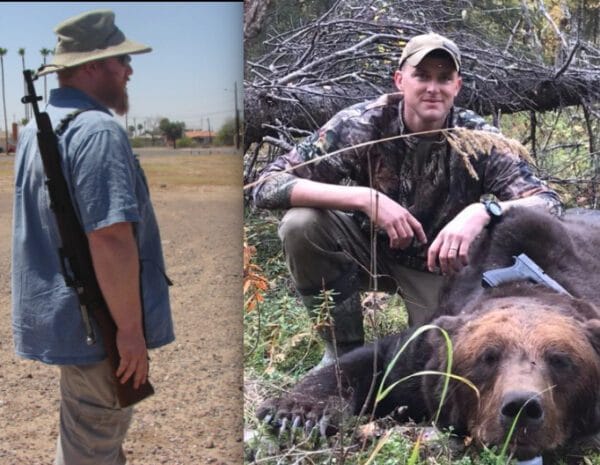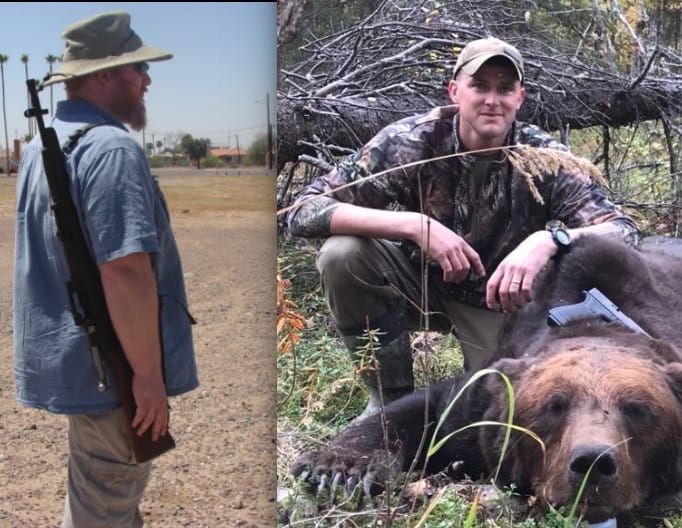
A surprising result of the research to determine if handguns are effective when used in defense against bears is that they appear to be more effective than rifles or shotguns. This is a surprise. Rifles and shotguns tend to be more powerful than pistols. They are also easier to use accurately at a distance. When expecting a bear encounter, the preferred firearm is almost always a high-powered rifle or a shotgun.
Terms become very important in this discussion. Rifles and shotguns are better tools for hunting bears than most defensive handguns.
Hunting is not the same as defending.
Much of the advantage of accuracy at the range of rifles and shotguns is eliminated because most defenses against bears occur at very close ranges. Defensive handguns have been designed with close-range defense in mind. They are specifically designed for quick access and repeated fast shots at close range.
In the study, Efficacy of Firearms for Bear Deterrence in Alaska, the authors found handguns to be marginally more effective than long guns, with long guns at 76% effective and handguns at 84% effective. Herrero and Smith, the authors of the study, note because of the small sample, this is not a statistically valid difference. The study included many instances where a firearm was not fired for various reasons.
One of the main reasons handguns appear to be more effective is because they are fired more often in defense against bears. Handguns are meant to be carried on the person, usually in a holster. Holsters are ergonomically designed and extensively tested to allow quick access during stress. The same holsters are designed to prevent the firearm from being lost during strenuous activity.
Rifles and shotguns are generally carried in the hands or on a sling. Most hunting slings are not designed for quick access. Many sportsmen carry their rifles and shotguns with an empty chamber. Many agencies require long guns to be carried with an empty chamber.
Carrying a long gun on a sling tends to slow the response time by a second and a half to three seconds if well practiced. Carrying with an empty chamber slows the response time by another three to five seconds if well practiced. Conversely, it is not difficult for most people to learn to draw and fire two aimed shots from a holster with a handgun in under two seconds. If not well practiced, when a firearm is carried with an empty chamber, many try to fire the first shot only to realize they have an empty chamber. This slows the response many more seconds. This information comes from a retired law enforcement firearms instructor with decades of experience who did considerable testing. This does not apply to tactical slings, where the delay can be relatively small. Few people carry long guns in tactical slings.
Another point to consider is that rifles and shotguns are more cumbersome than handguns. It’s not uncommon for a hunter to leave their rifle/shotgun some small distance from them. Rifles are often leaned against a tree, a wall, or a tent pole while chores are being done. They may be laid down on the ground, on a rock, or on a tent floor. A significant number of times, a person with a handgun will have the handgun on their person while a rifle will be a few feet away.
Once enough power is achieved for bullets to penetrate vitals and break bones, diminishing returns are encountered. A rifle or shotgun’s extra power and energy may not make much difference. Even relatively low-energy bullets hurt a great deal.
Because bear defense usually occurs at very close range, handguns have an advantage. They are easier to hold onto in a deadly fight against a bear where contact occurs. Because of their length, long guns can be more easily knocked away from a person. In confrontations with humans, it is easier to disarm someone who has a long gun than someone who has a handgun because the length of a long gun gives more leverage. It is easier to hold onto a handgun with one hand than it is to hold onto a long gun with one hand.
A final point to consider: there is selection bias in what is considered an attack makes handguns appear to be more effective.
Handguns, by their nature, tend to be used at very close range. If a long gun is used to deal with a bear at a longer range, the bear will likely be killed without any human injury. Those situations will seldom be classified or reported as a bear attack or even as an aggressive bear. Bear problems solved at long range with a long gun are seldom recorded as successful defenses. Bear problems solved at short range, where handguns have advantages, are likely to be classified as an aggressive bear defense or a bear attack. In the Herrero and Smith literature, a bear attack is defined as when a bear makes physical contact with a human. Under this definition, all successful defenses against bears, where the bear is killed or driven off before physical contact occurs, are not considered bear attacks.
The two factors, better availability and accessibility to handguns during bear encounters and the selection bias in favor of defenses against bears with handguns, are the reasons handguns appear to be more effective than long guns for defense against bears.
If people carried handy, high-capacity long guns in tactical slings with loaded chambers, ready to deploy in a fraction of a second, as a defense against bears, the results might be more effective than the 98% we see with handguns.
About Dean Weingarten:
Dean Weingarten has been a peace officer, a military officer, was on the University of Wisconsin Pistol Team for four years, and was first certified to teach firearms safety in 1973. He taught the Arizona concealed carry course for fifteen years until the goal of Constitutional Carry was attained. He has degrees in meteorology and mining engineering, and retired from the Department of Defense after a 30 year career in Army Research, Development, Testing, and Evaluation.






Handguns are utilitarian in nature. When EXPECTING trouble, carry a rifle. That said, Dean is right; a handgun is much quicker into the fight (if properly carried) and has more firepower. It is possible to get six well aimed hits in under a second with a revolver and you can add two or three rounds to that with a good semi auto. Nearly any “B” shooter can do this at your local competitions. I have seen video of cops doing mag dumps in under two seconds. A bear can outrun a horse so, if you are surprised up close, you… Read more »
Most handgun ammo will bounce off a bears skull….” Recent personal experience with handgun defensive ammo. Last deer season, friend wounded large buck. Trailed a mile, located down/alive in creek, struggling to get up. Used my EDC Kimber Micro 9 with un-named very popular defensive ammo to shoot deer three times……once in heart area, twice in head…..nothing, nada, barely a flinch. Embarrassingly, think we finally strangled it winching it up 30 ft high bank by arriving 4×4 assistance. Back at our lodge, found all three bullets embedded in the hide never penetrating the skin. So much for defensive ammo in… Read more »
This is why I agree with Paul Harrell about the so-called “hyper” ammos. https://www.youtube.com/watch?v=ayd4sxW_RUA IMO, the expansion required for the bullet to stop inside of the target, also means that if the target happens to be big and tough, or heavily clothed, then that amount of penetration could well be insufficient to reach the vitals. Meaning that all you accomplished with those external flesh wound(s) was to make your target angry! Living in sparsely populated Montana, overpenetration is generally the least of my worries, but I do understand that those in dense urban environments have a completely different set of… Read more »
I’ll carry a pistol in bear country. I don’t want to be a chaser for a shot of bear spray.
Yes my Ruger Blackhawk. 44 mag is heavier than a can of bear spray but it’s also been proven to be more effective on grizzley bears . Seasoning only appeals to me on my food .
S&W MP329 at 25oz in 44Mag (titanium and scandium frame/cyclinder) makes toting all day in chest holster much easier. Recoil in light handgun won’t be noticed during bear attack. However, I do like the extra capacity, faster reload of Glock G40 10mm with a Leupold Delta Point Pro. One considerable benefit of handgun over long gun is the ability to one hand turn gun for close shot if bear gets on one. With Bonnie Packer sling, one can carry long gun at the ready, even one or both hands free for other chores, and still have handgun in chest rig,… Read more »
I’m surprised that you choose a .44 mag. What about your username? .454 Casull/.45 Colt share the same one way interchangeability as .38 spl/.357 mag and .44 spl/.44mag do. I’d have thought that a Casull, but perhaps loaded with .45 colt… would be right up your alley.
🙂
Having shot bears with rifles, shotguns, and hand guns. When loaded with proper ammunition they are all capable of defending your self with. 10’s of thousands of bear are hunted and killed with one shot from firearms every year. Maybe a couple of bear hunters are hurt by their prey each year. Just using simple math if 10,000 bears are killed while hunting and 2 hunters are injured. That shows firearms are used very successfully. Firearms are used against bears successfully well over 99.8 plus percent of the time. Do not worry about your firearm being able to stop a… Read more »
more people get hurt hunting pigs
On the Sasquatch issue, I’ve never seen one, or their tracks. BUT(yes this is the “butter” part… 🙂 ), I have had Eskimo guides around Canoe Lake, Saskatchewan, tell me that they’ve seen them, and lots of their tracks. The natives that live there all have no doubt that they exist, so why in the world would I, a complete outsider with so little local knowledge that I hire the locals to guide me around, choose to argue with them? There might not be any in Montana (or in Central Park either), but there certainly are some in the northern… Read more »